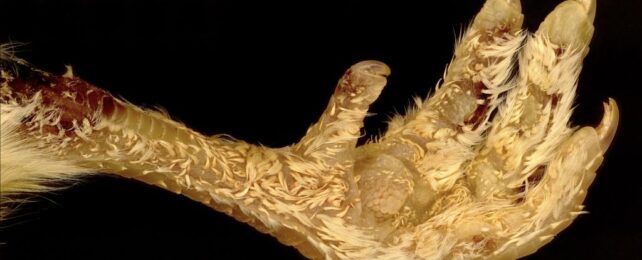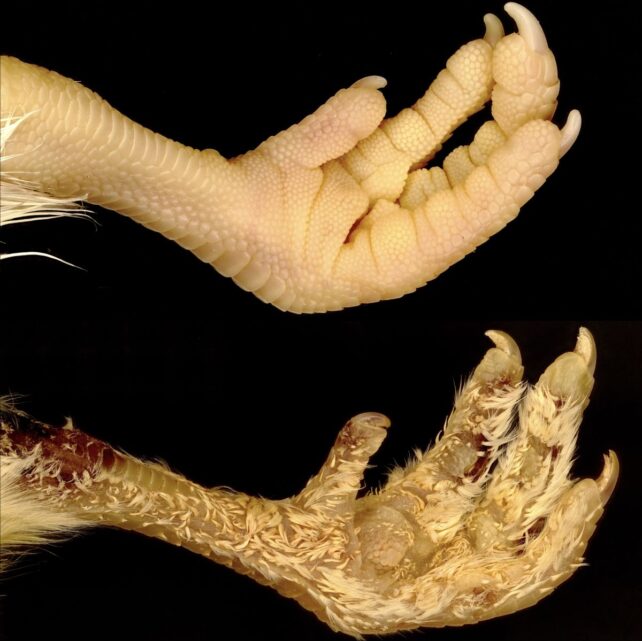
The feathers, fur, and scales that adorn different members of the animal kingdom may look quite different, but they're all made of the same basic stuff. And, as it turns out, it only takes a relatively simple genetic tweak to produce one instead of the other.
By targeting the sonic hedgehog (Shh) gene, geneticists Michel Milinkovitch and Rory Cooper of the University of Geneva in Switzerland altered embryonic chickens to grow feathers instead of scales on their usually squamous feet.
And the alteration is permanent. Once hatched, the chicken's unusually feathery feet will stay that way for life.
"We demonstrate that stage-specific transient agonism of sonic hedgehog (Shh) pathway signaling in chicken triggers a complete and permanent transition from reticulate scales to feathers on the ventral surfaces of the foot and digits," the researchers write.
"Resulting ectopic feathers are developmentally comparable to feathers adorning the body, with down-type feathers transitioning into regenerative, bilaterally symmetric contour feathers in adult chickens."
Previously, Milinkovitch's lab has demonstrated that the various keratinized skin appendages (hair, feathers, and so forth) have the same evolutionary origin in the ancestral reptilian hundreds of millions of years ago that later diversified into the incredible variety of animals living in the world today.
And in all these animals, the development of these structures begins as structures known as placodes in the skin, which thicken and then start to grow into the scales, spines, or whatever appendage that animal tends to have.
Shh plays a key role in the development of these skin appendages. The signaling pathway is an important one with its fingers in many embryonic pies, mediating the development of body shapes and structures, patterning, differentiation, and growth.
For instance, Shh is an important factor in feather form and diversification, flight feather positioning in birds, and the development of hair follicles in mice.
We know that some chickens, such as Brahmas, Sablepoots, and Silkies, have feathered feet, but the genetic mechanism that causes this was unknown. So Cooper and Milinkovitch decided to investigate by targeting Shh in embryonic chickens.

The target of the study was broiler chickens from chicken breeder brand Ross, which have very unfeathered, scaly feet. The researchers injected the veins of embryonic chickens still in the egg with a substance that promotes Shh pathway signaling to trigger the growth of feathers in areas normally covered with scaly skin.
"We used the classic technique of 'egg candling', in which a powerful torch illuminates blood vessels on the inside of the eggshell," Cooper explains.
"This allowed us to precisely treat chicken embryos with a molecule that specifically activates the Shh pathway, injected directly into the bloodstream."
It worked. When the chickens hatched, their normally bald feet were covered in downy juvenile feathers, similar to those covering their bodies. And, as the chickens grew, so too did the feathers.
They lost their baby down and grew adult feathers, not just on their bodies but on their feet, too. A single treatment in the egg was all it took to induce this change from scales to feathers.
Some eggs were treated with a control solution, which did not contain the active molecule that stimulated Shh pathway signaling in the experimental group.
The chickens hatched from these eggs had normal feet; RNA sequencing comparing the two groups showed that the changes wrought on Shh in the experiment group were permanent.
The researchers say this has implications for our understanding of how animals evolved and diversified. Natural variations in Shh signaling are probably an evolutionary driver of skin appendage diversity, and this diversity was not particularly difficult to achieve.
"Our results indicate that an evolutionary leap – from scales to feathers – does not require large changes in genome composition or expression," Milinkovitch says.
"Instead, a transient change in expression of one gene, Shh, can produce a cascade of developmental events leading to the formation of feathers instead of scales."
The research has been published in Science Advances.





No comments:
Post a Comment